|
 Dwight Peck's personal website Dwight Peck's personal website
Bassins,
Switzerland, 2002, on a budget 
In
summer 1998, Mr Peck vacated Trélex in haste and moved his books, computers, skis,
and a few clothes to a new little bachelor flat in the village of Bassins, Switzerland.
Bassin means 'pelvis'
in French, but that may not be related; it can also be used to mean 'bedpan'.
It also means 'water trough', and since we've got them in abundance all over the
village, possibly that's whence our ancestors fetched the name. Slightly more
than 800 "Bachenards" live here presently (1,200
by 2007), many in the old central village at 750 meters altitude, some
in the new upscale suburbs further up the hill, and a growing number in the very
new industrial-style villas currently being built off to the right.

The
entrance to the village, ascending from Gland or Nyon
on Lac Léman (Lake Geneva), with the ridgeline of the Swiss Jura up in
the distance. Mr Peck lives in the house dead center, just to the right of the
church --

This
one, in April 2002.

Here's
the same renovated farm building, built in 1868, from the other side, on the Rue
de l'Eglise. Mr Peck lives in the flat on the ground floor right, behind his stunningly
utilitarian blue VW "break" or station wagon. Extremely nice neighbors
live in the other three flats, and the kind owner lives in the adjoining main
house off to the right.

Here's
the Rue de l'Eglise in front of the house looking down into the Place des Tilleules
(lime or linden trees), the central village square, seen from the . . .
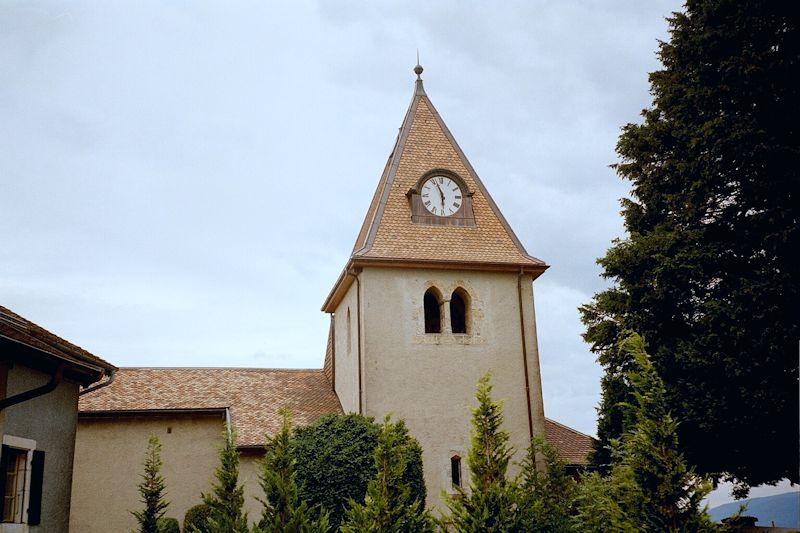
.
. . Eglise. This fine little hilltop church (with the troublesome clock), begun
in the 12th century, stands at the top of our street.

Our
front porch, so to speak.

Our
street again, the dead-end Rue de l'Eglise ("Church Street"), looking
down into the Place des Tilleules in the center of the village, where the shops
and the auberge ('hotel-restaurant') reside, as did the post office until 1 January
2002, at which time they did a little American-style cost-cutting ('in order to
compete') and closed it up entirely.

The
rue de l'Eglise in March 2003, on the occasion of the Bush invasion of Iraq.

The
central Place des Tilleules again, with the bookstore and bakery/pastry shop/tea
room in the center and the Rue de l'Eglise leading up on the right.
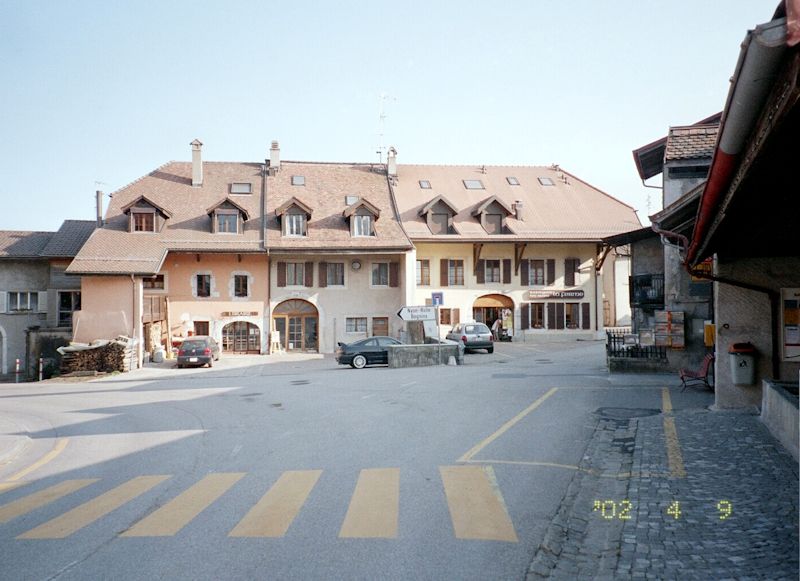
And
the bookstore and tearoom again from farther up the street.

A
little park in the center of the village, facing the auberge, with its flags and
petanque pitch.

Across
from the little park, the Hôtel de la Couronne (Crown Hotel) with its very
respectable restaurant and café, and the village administration buildings
and a large part of the village school included. The school bell tower dominates
the building.

The
auberge (or "inn") again from farther up the street.

The long
side of the auberge, with the village administration offices and, at the end,
the school.

Looking
back down the street towards the tearoom in the Place des Tilleules.

The
intersection from which the preceding photo was taken, looking uphill, past one
of the ubiquitous water troughs.

An
interesting old house on a small street out to the side of the village. Behind
it, however, lie some fairly disaesthetic villas still in construction. A whole
line of them, in fact, sort of salmon colored if you can imagine.
The
church

The
church was begun in the 12th century, evidently, and bits and pieces rebuilt and
restored over the intervening centuries . . .
Most
recently, the steeple.
| 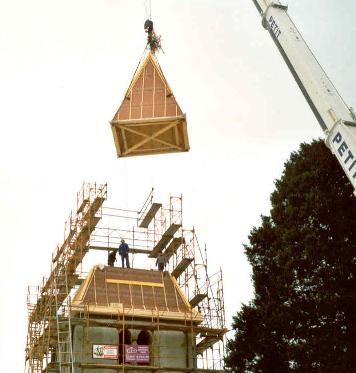
In
November 1999, the steeple was replaced by a new one, supposedly made in Yverdon
out of wood from the forests of Bassins. The process of installing it, in
two pieces, with tolerances of an inch within the scaffolding, was an artisanal
and engineering tour de force, worth spending a chilly morning off from work to
watch. | 
| 
At night.
Almost enough to make a decent person turn to religion.

From
the far side, amidst its comfortable and welcoming cemetery.
| Here's
an English translation of some background on the Cluniac associations, taken from
the entry in Les sites clunisiennes, http://fsc.cluny.free.fr/sites/bassins.htm.
The
church of Notre Dame of Bassins probably became Clunisienne in the 11th century,
following the donation made to Cluny by Humbert I, lord of Cossonay and of Prangins.
Pope Lucius III confirmed this Cluniac possession in 1183 and placed it under
the monastery of Payerne.
The
little priory that was born there seems to have been the centre of active agricultural
exploitation, and the seigniorial rights of the monks were allied to those of
the local lords - the sires of Prangins long held the right to represent the priory
in matters of justice and to carry out the punishment of those judged guilty.
The Prior of Payerne kept a strong hold on Bassins until the beginning of the
16th century, a period in which he named the châtelain and other officers
of the place. In 1536, the Protestant Reformation put an end to several centuries
of Cluniac presence in Bassins. Of
the whole rural priory of Bassins only the church of Notre Dame has survived,
of which the choir is the most ancient part; the foundations of the original building
have been found in the present cemetery. The oldest part probably dates from the
10th century, with additions in the 12th, 13th, 15th, and 16th centuries (like
the tower and the narthex, from a later era but of uncertain date). We know that
the little side chapel, dedicated to the Virgin, was founded in 1406 by a local
lord, Girard of Penezat. As to the larger chapel, also from the 15th century,
it is from the Brotherhood of the Holy Spirit that it had its origin. |
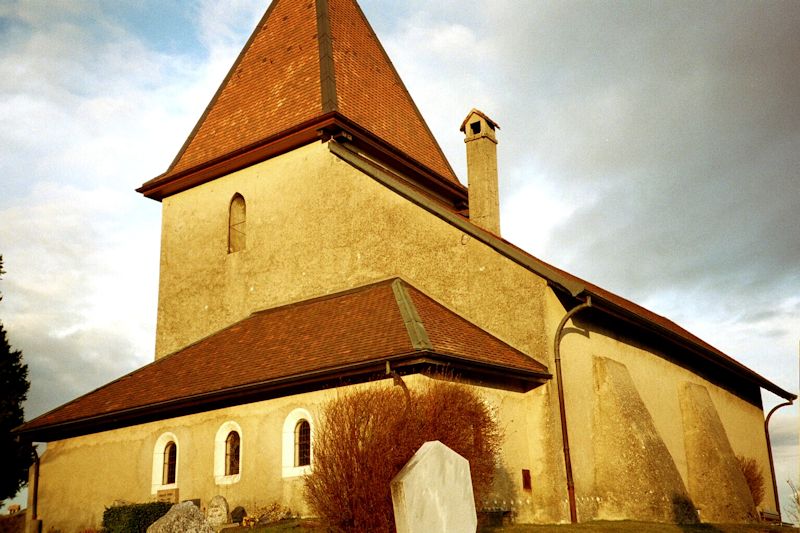
What
a lovely church! Mostly now disused, unfortunately. Weekly services were consolidated
about a year ago, presumably with a shrinking churchgoing population, to Begnins
nearby, and as nearly as a neighbor trying to sleep in on a Sunday morning can
tell from the bell-ringing patterns, it's now used mainly for weddings, funerals,
and a handful of regular services per year to keep the mold from growing on it.

And
a closing view of the Rue de l'Eglise, April 2002.


This
is our new computer, in October 2001, undergoing a little customizing.
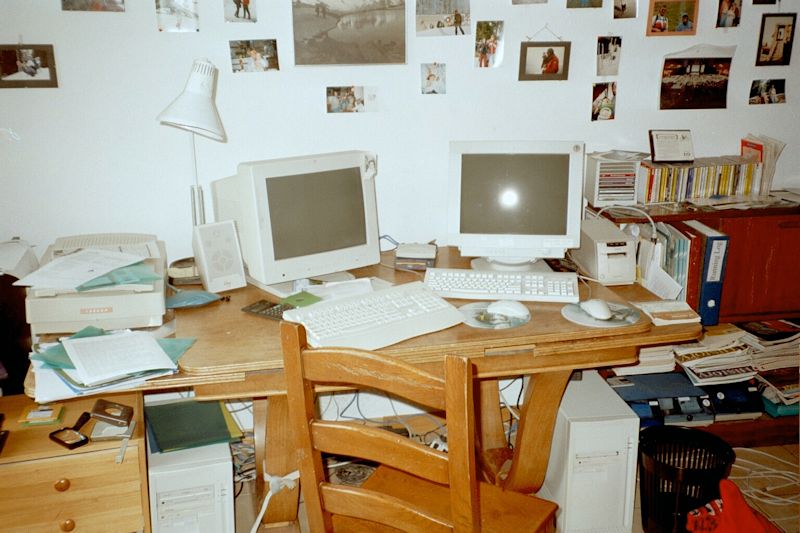
And
this is our cozy workstation, the diningroom table being put to good use next
to the livingroom window gazing out upon Lake Geneva, with the lights of the far
shore in France twinkling. A three-computer network, some scanners and what not,
plenty to keep us off the streets at night.

The
other end of our tiny livingroom. Not much else here -- a pullman kitchen, two
small bedrooms, more bathrooms than occupants, 3-foot-thick walls, and a fridge
full of beer with some frozen vegetables wedged in wherever they can be wedged.


Our
trusty and venerable mountain bike, named "Humvee", taking its end of
the year shower before going into hibernation for the winter, November 2001. (The
shower curtains were Mr Peck's favorites -- "The Little Mermaid" --
but Kristin got fed up with them and replaced them with "Aloha Hawaii".)

The
Swiss authorities took our fine old silver Toyota off the road for safety reasons,
but no worries, our garagist found us a nice inexpensive old blue Volkswagen "break"
(i.e., station wagon) that will hold skis, bicycles, backpacks and snowshoes,
iceaxes and old International Herald Tribunes, and a couple of sixpacks
just as well. Our normally gleaming VW is here suffering from an unexpected case
of Saharan sand storm across the Mediterranean, 8 April 2002 -- according to experts,
80,000 tons of African sand landed on Switzerland overnight. We ought to send
them back some of our water! [This photo got a little write-up
in Weatherwise magazine, March 2003.]
 Feedback
and suggestions are welcome if positive, resented if negative, Feedback
and suggestions are welcome if positive, resented if negative,  .
All rights reserved, all wrongs avenged. Posted 7 September 1998, revised 7 January 2011. .
All rights reserved, all wrongs avenged. Posted 7 September 1998, revised 7 January 2011.
|
 Dwight Peck's personal website
Dwight Peck's personal website


























